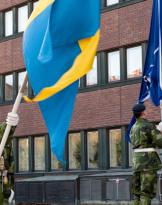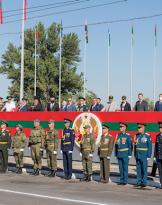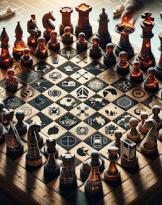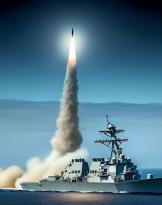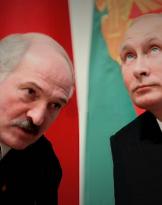The premise of what we are about to write is that, if you look at this map, you will be led to think that the Ukrainians since February 24 have lost almost a fifth of their territory despite their exceptional resistance to the Russian invasion.
So, however, you wrong Putin, who never ceases to repeat that Russians and Ukrainians have lived together as brothers for centuries. Not as brothers, we prefer to say, but as comrades! Yes, because the Ukrainians have grown up militarily in the old Russian school, the one that teaches not to waste scarce resources in keeping territories objectively indefensible, the one that invites the external aggressor to advance so that its supply lines become unsustainable and, finally, the one that it grants you to lose cities that for a Westerner are symbols but for a military strategist of the Russian Tsarist Empire or the Soviet Union they are only tools to wear down the enemy's forces as he advances. To this, however, the Kiev forces have added what Moscow lacks:
-
external partners available and quick to supply technologically advanced ammunition, equipment and weapon systems,
-
a railway network built in Soviet times to withstand a siege (even if imagined from the West, not the East),
-
a reformed military organization to be efficient even if not necessarily lean,
-
of the armed forces - military and paramilitary - in abundant and well-trained quantities, often according to NATO standards.
To this, we must add that Moscow suffers from the handicap of a centralized and authoritarian leadership, often resentful, which does not admit its mistakes and is constantly on the hunt for guilty parties to punish. In short, the Russians have a boss in the style of "arm ourselves and go", the Ukrainians a team that leads them.
The mad-hearted general
We said that Putin never stops looking responsible for his failures. It will be a coincidence that the "loyal" Shoigu has not shown himself in public for almost two weeks, circulates rumors of his heart disease and, when he appears in a conference call with the Kremlin, he is in a video that is several weeks old. Above all, he makes Westerners believe that the Pentagon knows everything, in detail and in advance, about Russian operations thanks to leakage of the FSB, while those who, until last February, had a direct line with Washington were him and his staff. Together with the joint chief of staff Gerazimov, the defense minister seems more interested in tying his image to the failure of a raid to take Kiev and the cities of eastern Ukraine, rather than the work of butchers who are carrying out his subordinates. , let's imagine under Putin's direct orders, in this last period.
Ethnic cleanups in progress?
 One hundred thousand in Mariupol, two hundred thousand in Kherson. Ukrainian civilians are between the feet of the Kremlin "butchers", helping to defend the "city of Mary" and protesting every day in the town north of Crimea. There are rumors of an imminent deportation, across the Russian border, of both populations, in order to punish the stubborn resistance of these Russian speakers to the "liberation" campaign waged by Moscow's elder brother. We recall that Russia has adopted, less than two months ago, rather disturbing legislation on mass burials and the transfer of populations from one territory to another. Below, you will find the cover of the law and a childish but effective description of how up to 800.000 bodies can be buried.
One hundred thousand in Mariupol, two hundred thousand in Kherson. Ukrainian civilians are between the feet of the Kremlin "butchers", helping to defend the "city of Mary" and protesting every day in the town north of Crimea. There are rumors of an imminent deportation, across the Russian border, of both populations, in order to punish the stubborn resistance of these Russian speakers to the "liberation" campaign waged by Moscow's elder brother. We recall that Russia has adopted, less than two months ago, rather disturbing legislation on mass burials and the transfer of populations from one territory to another. Below, you will find the cover of the law and a childish but effective description of how up to 800.000 bodies can be buried.
Mariupol: the occupation of the besieged in a city destined to fall
It erases the graffiti on the walls from the fifth column of Moscow in recent months: they are not signs for missile attacks or artillery strikes, but they indicate easy routes to penetrate the heart of the city. Take advantage of every rubble: a standing building is useless and with the streets around it facilitates the passage of the tanks and their cannonades; a collapsed building with the streets cluttered with rubble is an insuperable barrier for wagons even in the XNUMXst century, especially if the war recalls those of the early XNUMXth century. Spend the months preceding the conflict to train your troops and volunteers, to collect supplies of water and food not in large storage areas but in a thousand different places, to accumulate ammunition and weapons for a long siege and for the modern urban warfare. This done, wait for the enemy to advance. Keep him busy for weeks, months if possible. Distract him with symbolic objectives that are of no use to you but can cost him an entire battalion in a few hours. Take advantage of the fact that the enemy often does not follow the basic rules of war but is arranged in a column, perhaps behind a threatening TOS-1, forgetting that a deadly weapon that fires only in one direction and has three unguarded flanks is not decisive. . Don't waste shots: Sinking a ship carrying references or annihilating a ground-based helicopter squad counts as taking down a general. If not more. Train dozens of snipers, because even the day the last fighter is eliminated, they will continue to bleed the invader. Don't even think about whether you're Chechens or Russians: billionaire Kadyrov makes more noise in the newspapers than on the pitch. Repeat all this every day and, like those divisions that covered the Dunkirk retreat, don't even consider the possibility of being saved: your enemies have the goal of taking your land, you just have to take their life.
Kiev: one offensive lost, another is made
We are under no illusions: the cost of human life for the armed forces of all former Soviet countries is lower than that of bullets. This applies to the Russian attackers and, albeit with some caveats, to the Ukrainian defenders. Troop and officers are cannon fodder and they know it well: they have been trained not to care. For this reason, traditionally the Russian general staff, as it appears more and more in the media, does not invest in food, quality of life, safety of means or even in improving medical care for its fighters. Thus, once a strength of consistency has been reduced to a flicker in 60-70 km of vehicles and men placed in a column, they are preparing to launch another one on Kiev. It will start again from Belarus and perhaps it will also involve soldiers from Minsk led by Russian officers and non-commissioned officers, because you never know that once they enter Ukrainian territory they surrender to the enemy in order not to fight. The offensive will be preceded by bombings comparable to those that hammered Mariupol, because the Kremlin certainly does not care about the architectural and artistic masterpieces kept in the Ukrainian capital. If Washington is in time to deliver effective anti-missile systems to Kiev, the history of Mariupol, effectively reduced to rubble, will not repeat itself on a par. As for the overland advance, the broad gorge south of Antonov airport, the city of Chernihiv and the Brovary area are still waiting to be stormed. Maybe this time the Russians will succeed. Or maybe not. As for the missiles, it seems that between 50 and 60% of Russian missiles do not hit the target: in these conditions, they will fill the streets with rubble as the Ukrainian defenders cynically (but realistically) wish.
 Attack to the West
Attack to the West
And if the troops of Minsk - integrated by Russian men and means - and those of Transnistria were launched in a pincer maneuver from the north (in the south-east direction) and from the south (in the north-west direction) over western Ukraine, for to cut off supplies from the Polish border to Kiev? If Guderian were driving them and if the distance between the two extremes were not more than 700 km, all within the most hostile and densely populated area of Ukraine, it could also work. However, to descend from Brest, where the southern army of Belarus is located, to Lusk oblast you can only cross two or three gorges, where the orography does not play in favor of the attackers. The case of penetration in a north-northwest direction from Transnistria is different: it could advance far enough to create an obstacle, even if it would risk bagging and would find itself with unsustainable supply lines. Also the Russian separatists of Moldova could be headed south-east towards Odessa. However, the city has excellent artillery to defend it.
Attack on Poland
Once we get to the period between May XNUMX and XNUMX, Labor Day and the anniversary of the victory in World War II, if the Russians have not permanently occupied Kiev and the Ukrainians will still have sufficient fighting capacity to inflict significant damage on forces of Moscow, then the Kremlin could take the decision to extend the war to Poland, hitting the bases on the border between Poland and Ukraine with conventional missiles or tactical nuclear warheads. Yes, this would represent an escalation of the conflict and lead to a reaction from NATO. However, Putin is likely to believe that this response would not be directed against Russia, in order not to trigger a nuclear war, but would only affect the territory of Ukraine and possibly Belarus. A widening of the conflict could justify, on the domestic front, the liberticidal measures and the persistence of censorship, as well as further use of tactical nuclear weapons on Ukrainian territory in order to induce the government of Kiev to surrender.
Before we finish, let's not forget that Russia also has limits linked to the country's economy, regardless of sanctions. A comparative analysis speaks volumes about the weaknesses of the Eurasian giant:
-
the federal budget is the size of the Spanish one, i.e. one fifteenth of the United States, one ninth of the People's Republic of China and one quarter of Germany,
-
military spending is thirteen and four times lower than in Washington and Beijing,
-
the Russian GDP is lower than that of Italy, Canada and South Korea: despite having less than a third of the Russian population, the Spanish GDP is just 10% lower,
-
Russian GDP per capita is lower than that of mainland China, Romania and Iran, more or less like that of Bulgaria, that is, the poorest country in the European Union: referring only to Russia's "showcase", namely Moscow , the per capita GDP of the Russian capital's oblast is comparable to that of Montenegro while many provinces do not reach the "wealth" of Djibouti and Bhutan,
-
the life expectancy of an adult man in Russia is lower than that of one in Moldova, Guatemala and Nepal, almost 14 years lower than in Italy,
-
the Russian government's per capita health expenditure is lower than Bulgaria, Montenegro and Romania,
-
the Russian government offers these services and investments to a population of 145 million, the ninth largest in the world.
The conclusion of our reasoning is that in the next 5-6 weeks the war should move from the south-eastern quadrant to the northern and western one, given the double mission of Moscow to take the Ukrainian capital and stop supplies. If no major goals are achieved and Putin's leadership survives, the widening of the war will be inevitable.




